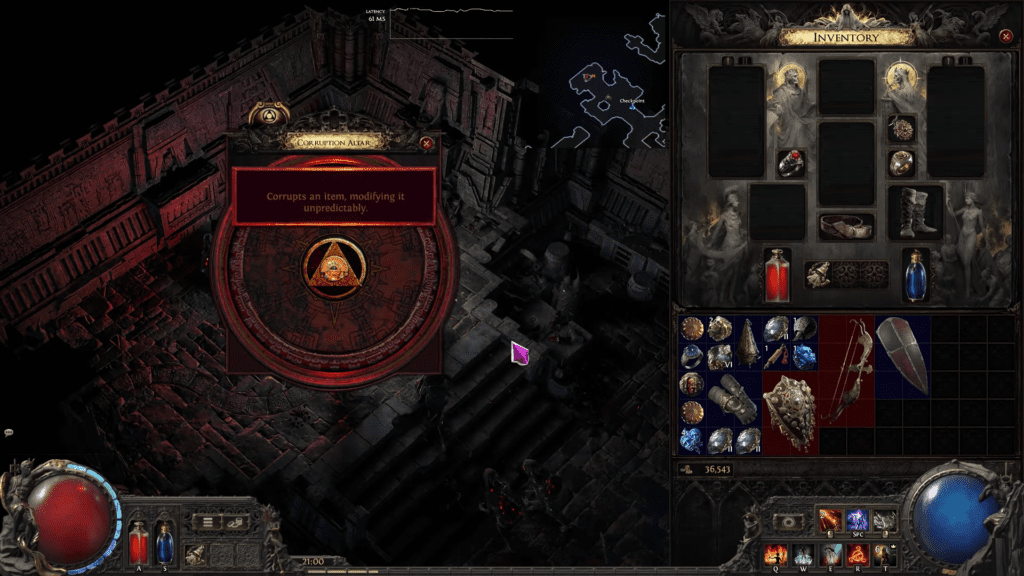Path of Exile 2 offers many ways to upgrade your gear, corrupting an item is one of the best ways to add more to the gear but it carries tremendous risk as well. Vaal Orb is one of the most interesting materials in the game as it’s about corrupting a weapon. But the game also features an Altar of Corruption, the best alternative to Vaal Orb in the game. This guide will help you pick up everything need to know about Altar of Corruption.
How To Corrupt An Item In Path Of Exile 2

There are two ways we can corrupt an item in PoE2; either by using the Vaal Orb or the Altar of Corruption.
Using Altar Of Corruption
- Interact with the Corruption Altar.
- The corruption menu pop-up box will appear.
- Drag the triangle shape from the middle of the circle and drop it into any item that you want to corrupt.
Using Vaal Orbs
Once you have a Vaal Orb in your possession, just drag the orb to any weapon you want to corrupt. In an instant, the item will be labeled as a Corrupted Item. However, the Vaal Orb can be hard to come by in the early section of the game. You must make it to Act III of the game to see the orb drop rates increase. So early on, if you don’t have a Vaal Orb in your inventory; you can fall back to the Altar of Corruption.
While both approaches (Vaal Orb and Altar) to corruption are different, the principle in both cases stays the same. The Corruption system works very much the same, on the Vaal Orb or the Altar of Corruption Side. They are both alternatives to each other, so if you find yourself with no Vaal Orbs in your inventory, you can choose to go with Altar of Corruption and vice versa.
How To Get Altar Of Corruption In Path Of Exile 2
The Altar of Corruption will not appear on the map like common altars. The first Corruption Altar shows up around Act II at Vaal Ruins. You are going to find a guaranteed Corruption Altar in Jiquani’s Sanctum.
Should You Corrupt Your Gear In Path Of Exile 2?

It depends, on if you are willing to pay the risk for corruption.
Now we come down to the most important question of them all, should you even think about corrupting a gear. The answer lies in understanding the best possible outcome for the gear and simultaneously learning about the worst.
Best Outcome:
- Corrupting an Item can grant one extra affix or modifier to the weapon.
- Reroll half your item modifiers. If the weapon is Unique (Orange Color) then corruption can reroll the unique modifier.
- It can even add a new socket entry to the item.
- And last, but not least, you would get nothing out of it. The only change you will see here is in the name, as the item will be labeled as Corrupted.
Worst Outcome:
- If the item you are corrupting goes into the category of Unique, then corruption can remove affixes from the item.
- Corrupting a Unique item can also downgrade the item to Rare. You would go from having an Orange colored weapon to a common Yellow Rare.
The same rules hold to the Skill Gem Corruption as well. Here we are seeing high-risk high-reward scenarios. But the risks seem to outweigh the good here. Now let’s take a look at all the limitations that apply once an item gets labelled as corrupted in Path of Exile 2.
Limitations To A Corrupted Item In Path Of Exile 2
Once the item gets corrupted, whether with a bad or good outcome, it will have to follow the rules of a corrupted item; which are:
- A corrupt item can’t be upgraded
- You can never improve the corrupt items with Blacksmith Whetstone or Armourer’s Scrap.
- You can’t add any extra affixes to the corrupted items; or use an Exalted Orb on these items.
- You can’t add any Gem Sockets to the corrupted items.
- And lastly, you lose the ability to reroll any affixes for the corrupted items using Chaos Orbs.
Any item in the game can only be corrupted once, so choose wisely the weapon you want to improve as you can see, once the item gets labeled as corrupted it will lose all of its perks as a common item in the game.
Since you are here, you may also want to take a look at our article that gives the complete crafting mechanics guide to Path of Exile 2.


